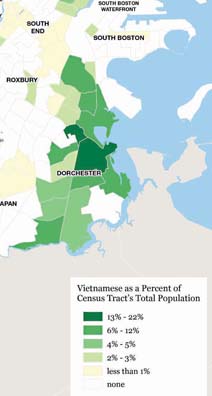March 20, 2014
 Vietnamese population mapFrom Irish, Jews, and Italians to Vietnamese, Haitians and Cape Verdeans, a new map exhibition covering the past 100 years shows Boston’s changing population. “City of Neighborhoods: The Changing Face of Boston” opens Saturday, March 22, at the Norman B. Leventhal Map Center at the Boston Public Library in Copley Square.
Vietnamese population mapFrom Irish, Jews, and Italians to Vietnamese, Haitians and Cape Verdeans, a new map exhibition covering the past 100 years shows Boston’s changing population. “City of Neighborhoods: The Changing Face of Boston” opens Saturday, March 22, at the Norman B. Leventhal Map Center at the Boston Public Library in Copley Square.
“The original inspiration was all of this great data that came out of the 2010 census,” said Michelle LeBlanc, director of education at the Leventhal Map Center and co-curator of the show. “It told us about what has been going on with population and demographics, and being the map center we wanted to show this through maps.”
As researchers pulled the information together, it was clear that each neighborhood had its own story within the larger picture of the city of Boston, LeBlanc said.
The story for the largest neighborhood — Dorchester— is that it has become the most diverse area of the city, with its large Vietnamese and Cape Verdean populations, LeBlanc said. The six largest foreign-born groups also include Chinese, Dominican, Colombian, and El Salvadorian, she said.
Each of those six groups gets its own map at the map center, showing where that population lives within the city, according to co-curator Evan Thornberry.
Dorchester also contains the highest percentage of children in the city. Children under 18 make up about 30 percent of the neighborhood, according to LeBlanc.
The exhibition begins with 1910, when Boston was the second largest port of entry for immigrants after New York City, according to LeBlanc. Dorchester’s largest immigrant groups then were Irish and Anglo-Canadians.
At the time, the U.S. Census measured Boston’s population at 670,585, higher than the latest population estimate of 636,479 in 2012. Boston saw a serious decline in population between 1950 and 1980, but in the past 30 years the city has been growing again, according to Census numbers.
Part of the explanation is that neighborhoods like the North End – where some single-bedroom apartments housed eight people – have become less dense, LeBlanc said.
The largest Jewish population in the area used to be in East Boston, with other city neighborhoods also containing Jews, but the group moved out to outlying cities and towns in the latter half of the 20th century, LeBlanc said. A Haitian church in the Blue Hill Avenue neighborhood used to be a synagogue and reflects the changes in the area, she said.
The new growing population in Boston includes one of the largest Cape Verdean communities in the country, which originally came to the area to pursue whaling, LeBlanc said.
East Boston remains 50 percent foreign-born, and 47 percent of children in the Boston Public Schools speak a language other than English at home, according to LeBlanc.
Seeing the exhibition at the library is free, but those interested will also be able to see it online, as well, according to Thornberry. Information has been translated into the top three languages spoken in Boston other than English – Spanish, Haitian Creole, and Chinese.
“We’re very committed to presenting things on the web,” said map center executive director Janet Spitz. “We have 5,500 maps in our collection and we add about 100 every month. The goal is to get those up there on the website by creating online exhibitions.”
The website is maps.bpl.org.
Still, the online exhibition is not a replacement for seeing the maps themselves, according to Thornberry.
“Maps have a certain physicality to them; the way maps work is with a large space,” he said. “I also think that especially with historic maps, there is something about having the old item in front of you.”
As part of the exhibition opening, there will be children’s activities including geography games, map-making activities, and live Cape Verdean music played by Cruzamente, all held in the Boston Room and the Commonwealth Salon at the Central Library in Copley Square.
The center is open Monday to Thursday from 10 a.m. to 7 p.m., Friday and Saturday from 10 a.m. to 5 p.m., and on Sunday from 1 to 5 p.m.


